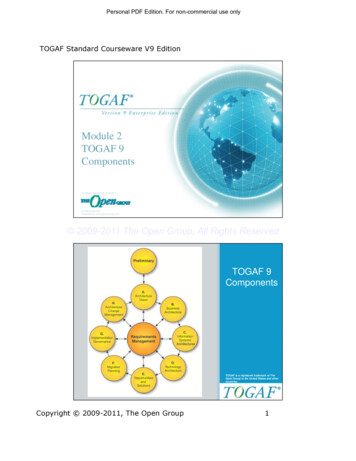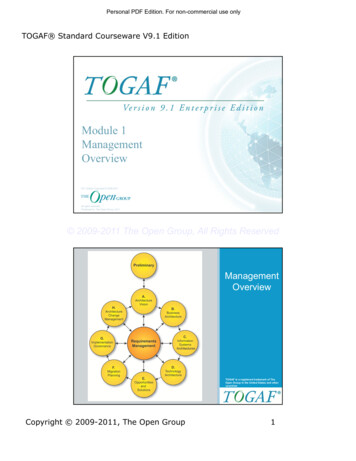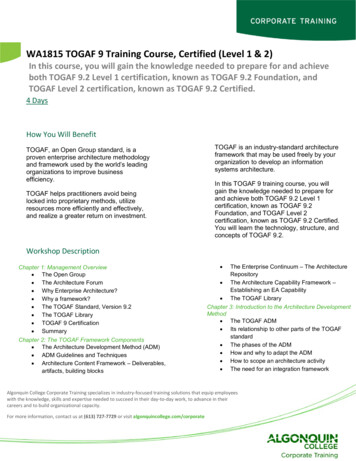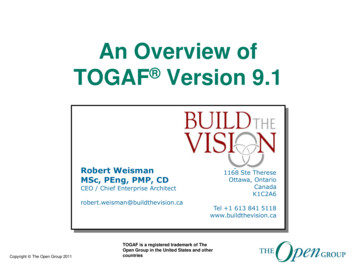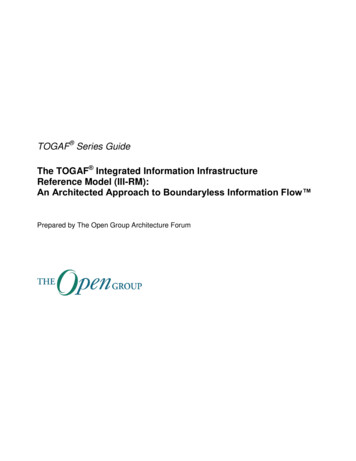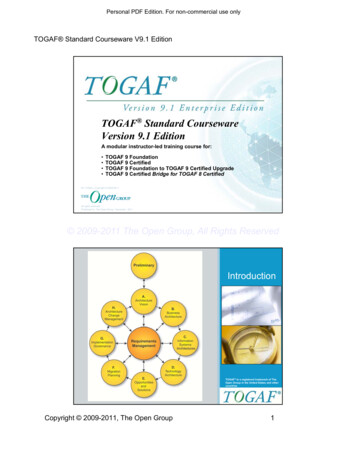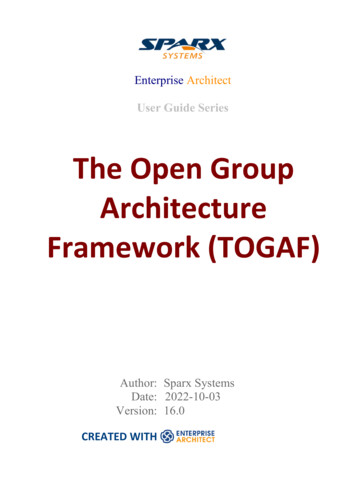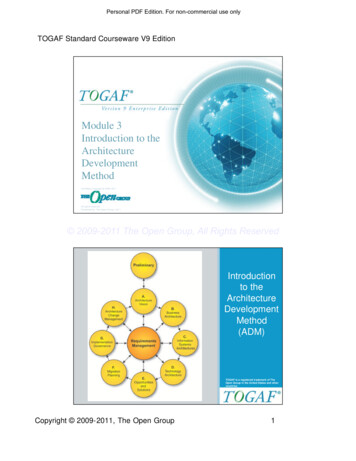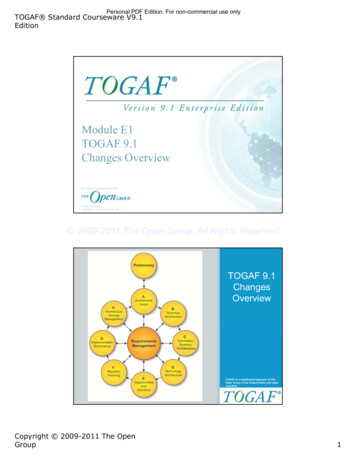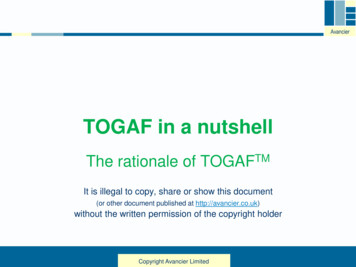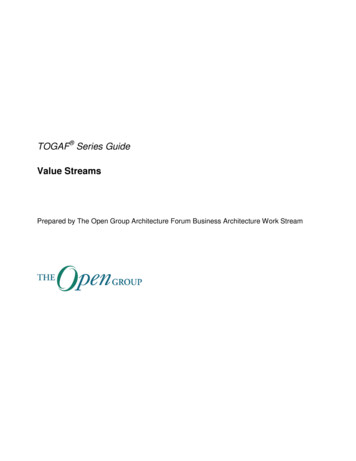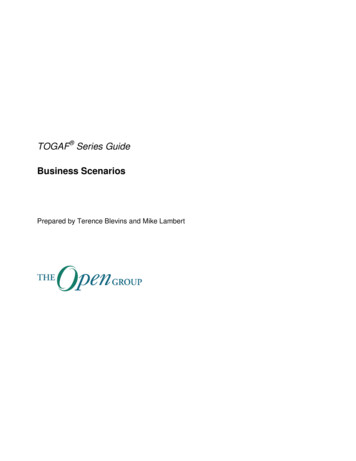
Transcription
TOGAF Series GuideBusiness ScenariosPrepared by Terence Blevins and Mike Lambert
Copyright 2017, The Open Group. All rights reserved.No part of this publication may be reproduced, stored in a retrieval system, or transmitted, in any form or by any means,electronic, mechanical, photocopying, recording, or otherwise, without the prior permission of the copyright owner.This Guide has not been verified for avoidance of possible third-party proprietary rights. In implementing this Guide,usual procedures to ensure the respect of possible third-party intellectual property rights should be followed.TOGAF Series GuideBusiness ScenariosISBN:1-947754-00-3Document Number:G176Published by The Open Group, September 2017.Updated in May 2018 to reference the TOGAF Standard, Version 9.2.Updated in January 2019 with minor corrections for alignment with the TOGAF Standard, Version 9.2.Comments relating to the material contained in this document may be submitted to:The Open Group, Apex Plaza, Forbury Road, Reading, Berkshire, RG1 1AX, United Kingdomor by electronic mail to:ogspecs@opengroup.orgiiTOGAF Series Guide (2017)
Contents1Introduction . 12Benefits of Business Scenarios . 43Creating the Business Scenario . 63.1 The Overall Process . 63.2 Steps. 83.2.1Planning Step. 83.2.2Gathering Step . 83.2.3Analyzing Step . 103.2.4Documenting Step . 113.2.5Reviewing Step. 113.3 Phases . 123.3.1Premise Formulation Phase . 123.3.2Initial Verification Phase . 133.3.3Refinement Phase . 134Contents of a Business Scenario . 155Contributions to the Business Scenario. 176Business Scenarios and the TOGAF ADM . 187Developing Business Scenarios . 197.1 General Guidelines . 197.2 Questions to Ask for Each Area. 197.2.1Identifying, Documenting, and Ranking the Problem . 197.2.2Identifying the Business and Technical Environmentand Documenting in Models . 207.2.3Identifying and Documenting Objectives . 207.2.4Identifying Human Actors and their Place in theBusiness Model . 207.2.5Identifying Computer Actors and their Place in theTechnology Model . 217.2.6Documenting Roles, Responsibilities, Measures ofSuccess, and Required Scripts . 217.2.7Checking for Fitness-for-Purpose and Refining, ifNecessary . 218Business Scenario Documentation . 228.1 Textual Documentation. 228.2 Business Scenario Models . 22Business Scenariosiii
iv9Guidelines on Goals and Objectives . 249.1 The Importance of Goals . 249.2 The Importance of SMART Objectives . 249.2.1Example of Making Objectives SMART . 249.3 Categories of Goals and Objectives . 259.3.1Goal: Improve Business Process Performance . 269.3.2Goal: Decrease Costs. 269.3.3Goal: Improve Business Operations . 269.3.4Goal: Improve Management Efficacy . 269.3.5Goal: Reduce Risk . 269.3.6Goal: Improve Effectiveness of IT Organization . 279.3.7Goal: Improve User Productivity . 279.3.8Goal: Improve Portability and Scalability . 279.3.9Goal: Improve Interoperability . 289.3.10 Goal: Increase Vendor Independence . 289.3.11 Goal: Reduce Lifecycle Costs . 289.3.12 Goal: Improve Security . 299.3.13 Goal: Improve Manageability. 2910Roles . 3011Checklists . 3111.1 Checklist – Premise Formulation . 3111.2 Checklist – Plan . 3111.3 Checklist – Gather . 3211.4 Checklist – Analyze . 3311.5 Checklist – Document. 3311.6 Checklist – Review . 3412Techniques and Tips . 3512.1 On Active and Reflective Listening . 3512.2 On Brainstorming and Affinity Analysis . 3612.3 Introduce your Neighbor . 3612.4 We Believe. 3612.5 On Money or Credit Voting Prioritization . 3712.6 On Multi-Voting and Rank Ordering Prioritization. 3712.7 On Role Play . 3712.8 On Alternative Analysis and Decision Matrix . 3813Summary . 39TOGAF Series Guide (2017)
PrefaceThe Open GroupThe Open Group is a global consortium that enables the achievement of business objectivesthrough technology standards. Our diverse membership of more than 600 organizations includescustomers, systems and solutions suppliers, tools vendors, integrators, academics, andconsultants across multiple industries.The Open Group aims to: Capture, understand, and address current and emerging requirements, establish policies,and share best practices Facilitate interoperability, develop consensus, and evolve and integrate specifications andopen source technologies Operate the industry’s premier certification serviceFurther information on The Open Group is available at www.opengroup.org.The Open Group publishes a wide range of technical documentation, most of which is focusedon development of Open Group Standards and Guides, but which also includes white papers,technical studies, certification and testing documentation, and business titles. Full details and acatalog are available at www.opengroup.org/library. The TOGAF Standard, a Standard of The Open GroupThe TOGAF standard is a proven enterprise methodology and framework used by the world’sleading organizations to improve business efficiency.This DocumentThis document is a TOGAF Series Guide to Business Scenarios. It has been developed andapproved by The Open Group.Business Scenarios provide a mechanism to fully understand the requirements of informationtechnology and align it with business needs. This is accomplished through the analysis ofbusiness processes, supporting IT components, and information flow requirements. BusinessScenarios are an essential tool used by the successful manager to achieve BoundarylessInformation Flow .The document supersedes G261: Manager’s Guide to Business Scenarios.More information is available, along with a number of tools, guides, and other resources, atwww.opengroup.org/architecture.Business Scenariosv
About the TOGAF Series GuidesThe TOGAF Series Guides contain guidance on how to use the TOGAF framework. They formpart of the TOGAF Body of Knowledge.The TOGAF Series Guides are expected to be the most rapidly developing part of the TOGAFdocument set. While the TOGAF framework is expected to be long-lived and stable, guidance onthe use of the TOGAF framework can be industry, architectural style, purpose, and problemspecific. For example, the stakeholders, concerns, views, and supporting models required tosupport the transformation of an extended enterprise may be significantly different than thoseused to support the transition of an in-house IT environment to the cloud; both will use theArchitecture Development Method (ADM), start with an Architecture Vision, and develop aTarget Architecture on the way to an Implementation and Migration Plan. The TOGAFframework remains the essential scaffolding across industry, domain, and style.viTOGAF Series Guide (2017)
TrademarksArchiMate , DirecNet , Making Standards Work , OpenPegasus , Platform 3.0 , The OpenGroup , TOGAF , UNIX , UNIXWARE , and the Open Brand X logo are registeredtrademarks and Boundaryless Information Flow , Build with Integrity Buy with Confidence ,Dependability Through Assuredness , Digital Practitioner Body of Knowledge , DPBoK ,EMMM , FACE , the FACE logo, IT4IT , the IT4IT logo, O-DEF , O-PAS , OpenFAIR , Open O logo, Open Platform 3.0 , Open Process Automation , Open TrustedTechnology Provider , SOSA , and The Open Group Certification logo (Open O andcheck ) are trademarks of The Open Group.All other brands, company, and product names are used for identification purposes only and maybe trademarks that are the sole property of their respective owners.Business Scenariosvii
About the AuthorsTerence (Terry) Blevins, Fellow of The Open Group; Owner of Enterprise Wise LLCTerence Blevins, a Fellow of The Open Group, is owner of Enterprise Wise LLC and a semiretired Enterprise Architect. He is currently a Director of The Open Group Governing Board.He has been involved with the architecture discipline since the 1980s, mostly while he wasDirector of Strategic Architecture at NCR Corporation. Terence has been involved with TheOpen Group since 1996 when he first was introduced to the Architecture Forum. He was cochair of the Architecture Forum and a frequent contributor of content to the TOGAF standard,including the Business Scenario method.Terence was Vice-President and CIO of The Open Group where he contributed to The OpenGroup Vision of Boundaryless Information Flow .He holds undergraduate and Masters degrees in Mathematics from Youngstown StateUniversity. He is TOGAF 8 Certified.Mike Lambert, Fellow of The Open GroupMike was one of the pioneers of the TOGAF standard. As Chief Technical Officer for TheOpen Group, he was the Technical Editor for the IEEE 1003.0 architecture standard in the late1980s and responsible for the development of the TOGAF standard with The Open Group untilthe publication of the TOGAF 8 standard. Mike joined X/Open Company Limited (one of thepredecessors of The Open Group) in 1984 from ICL, where he had a variety of roles leading upto Chief Architect for OMAC 29, ICL’s flagship product for the Manufacturing Industry andDesign Authority for all ICL’s vertical application products. As Chief Technical Officer inX/Open and The Open Group, Mike was responsible for technical strategy and presided over theinitial standardization of the UNIX operating system.On leaving The Open Group in April 2003, Mike was appointed as the first Fellow of The OpenGroup, in recognition of his extensive contribution to the development of Open Systems andArchitecture. Between 2003 and 2005, Mike continued to work closely with The Open Group, asForum Director of the Messaging Forum and providing secretariat services to the ArchitectureForum. Between 2005 and 2015, Mike was Chief Technical Officer and Principal Instructor forArchitecting-the-Enterprise Ltd., with specific responsibility for the development, delivery, andquality of the Architecting-the-Enterprise TOGAF training business. Between 2004 and 2011,Mike was a Lecturer in Information Systems and Enterprise Architecture at undergraduate andpostgraduate level at the University of Reading.In 2005, Mike was given an award for Excellence in Teaching by the University of Reading.In 2012, Mike was awarded the Lifetime Achievement award by The Open Group.viiiTOGAF Series Guide (2017)
AcknowledgementsThe Open Group gratefully acknowledges the authors – Terry Blevins and Mike Lambert – andalso past and present members of The Open Group Architecture Forum for their contribution inthe development of this Guide.Business Scenariosix
ReferencesThe following documents are referenced in this Guide:x The TOGAF Standard, Version 9.2, a standard of The Open Group (C182), published byThe Open Group, April 2018; refer to: www.opengroup.org/library/c182 TOGAF Series Guide: Business Capabilities (G189), June 2018, published by The OpenGroup: refer to: www.opengroup.org/library/g189 TOGAF Series Guide: Business Models, (G18A), published by The Open Group, June2018; refer to www.opengroup.org/library/g18a TOGAF Series Guide: Value Streams (G178), October 2017, published by The OpenGroup: refer to: www.opengroup.org/library/g178TOGAF Series Guide (2017)
1IntroductionA key factor in the success of an Enterprise Architecture is the extent to which it is linked tobusiness requirements, and demonstrably supporting and enabling the enterprise to achieve itsbusiness objectives. Any architectural effort must begin with a baseline view of the needs to befulfilled by the solution or solutions. Consider guiding the construction of a warehouse buildingwithout understanding why the warehouse is needed. This could result in a fine warehousesolution for housing large-scale mechanical parts; however, the need was a warehouse forhousehold goods. Creating an architecture without understanding “why” typically results inmismatches between solutions and needs.The Business Scenario method is a technique to validate, elaborate, and/or change the premisebehind an architecture effort by understanding and documenting the key elements of a BusinessScenario in successive iterations where: Each iteration requires planning, data gathering, analysis, documentation, and review Each iteration should improve one or more of the key elements Iterations are repeated until your understanding is fit-for-purpose for deciding to moveforwardNot examining all elements of a Business Scenario carries a risk of producing an incompletesolution, but care must be taken not to iterate unnecessarily.The Business Scenario method may be used at various stages of developing an EnterpriseArchitecture – principally the Preliminary, Architecture Vision, and Business Architecturephases – but in other architecting phases as well, if required, to derive the characteristics of thearchitecture directly from the high-level requirements of the business. The technique is used tohelp identify, understand, and document business needs, and thereby to derive the businessrequirements that the architecture development has to address. These business requirements aredocumented as a Business Scenario.A Business Scenario is a uniform description of: Real business problems The business and technology environment in which those problems occur Value streams enabled by capabilities The desired outcome(s) of proper execution The human and computing components (the “actors”) who provide the capabilitiesA good Business Scenario is also “SMART”: Specific, by defining what needs to be done in the business Measurable, through clear metrics for successBusiness Scenarios1
Actionable, by:— Clearly segmenting the problem— Providing the basis for determining elements and plans for the solution Realistic, in that the problem can be solved within the bounds of physical reality, time,and cost constraints Time-bound, in that there is a clear statement of when the solution opportunity expiresChapter 9 provides detailed examples of outcomes that should be considered. Whateveroutcomes are used, the idea is to make those outcomes SMART.Below are further notes on Business Scenarios and the Business Scenario method: Business Scenarios are not just about IT, even though that was their genesisBusiness Scenarios are just as much about understanding business value, value streams,and business outcomes and what resources in general are required to improve the valuestreams and meet outcomes to deliver business value. Business Scenarios are not specific to the IT industry, rather the technique can be appliedto help understand the requirements in any industry such as Healthcare, Transportation,Oil and Gas, Lottery, etc. Business Scenarios are not just relevant to big problem areas; the technique can be appliedto very large general problems areas such as standards for National Lotteries, or verysmall focused problem areas such as retail Point of Sale upgrades Business Scenarios, just like architectures, are not the end game – the end game isachieving the desired business outcomesThus, there must be a downstream path for using the Business Scenario to drive thearchitecture work which must faithfully drive implementation of solutions. Business Scenarios are statements at a specific time and should be updated to reflectsignificant changesBusiness Scenarios are not: Use-cases (as in OMG, Rational SW, ); use-cases are:— More detailed descriptions of human to computer interaction— Typically used in software development projects Business models nor business cases nor Business Scenario plans (as in Forbes ):— However, a Business Scenario can be informed by a company’s business model— A SMART Business Scenario can inform a business case and/or a business modeland/or Business Scenario plan SPIN (as in Situation, Problem, Implication, Need Payoff selling strategy):— SPIN is a sales technique that can be used to gather information for a BusinessScenario2TOGAF Series Guide (2017)
— A Business Scenario can provide the seller some relevant “context” for a SPINengagement A substitute for any typical engineering specifications (as from IEEE):— Which are much more detailed, material-specific, and tied more to scienceBusiness Scenarios3
2Benefits of Business ScenariosA Business Scenario is essentially a complete description of a business problem, both inbusiness and in architectural terms, which enables individual requirements to be viewed inrelation to one another in the context of the overall problem. Without such a completedescription to serve as context: There is a danger of the architecture being based on an incomplete set of requirements thatdo not add up to a whole problem description, and that can therefore misguide architecturework The business value of solving the problem is unclear The relevance of potential solutions is unclearAlso, because the technique requires the involvement of business line management and otherstakeholders at an early stage in the architecture project, it also plays an important role ingaining the buy-in of these key personnel to the overall project and its end-product – theEnterprise Architecture.An additional advantage of Business Scenarios is in communication with vendors. Mostarchitecture today is implemented by making maximum use of Commercial Off-The-Shelf(COTS) software solutions, often from multiple vendors, procured in the open market. The useof Business Scenarios by a customer can be an important aid to vendors in delivering appropriatesolutions. Vendors need to ensure that their solution components add value to an open solutionand are marketable. Business Scenarios provide a language with which the vendor communitycan link customer problems and solutions. Besides making obvious what is needed, and why,they allow vendors to solve problems optimally, using open standards and leveraging eachother’s skills.Creating a Business Scenario takes time and effort and if done right there is a return on thisinvestment summarized in the following list. If not done, or done wrong, more of the sameissues will exist between solutions developers and the actual business. Better solutions – by understanding the real needs and how solving these needs are valuedby the business, solutions can be brought to bear that are clearly aligned to the businessand enable new capabilitiesBy meeting with the leaders of the business and bringing better solutions to the table, arelationship develops that is repeatable, resulting in a virtuous cycle of bringing in newcapabilities. Faster to realize capabilities – by understanding the real needs, and the timelinerequirements associated with fulfillment of those needs, solutions can be brought to bearin a timed sequence rather than in a single big-bang approachThis results in faster implementations of incremental value aligned to business needs. Thisis also consistent with Agile and DevOps approaches to solving problems.4TOGAF Series Guide (2017)
Cheaper costs – by understanding real business needs and addressing them incrementallythe ultimate savings are in costs – both costs saved and costs avoidedExamples of costs saved are implementing only what is needed and eliminatingredundancy. Examples of costs avoided are eliminating the costs of failedimplementations and lowering the costs of integration and interoperation.Business Scenarios5
3Creating the Business Scenario3.1The Overall ProcessCreating a Business Scenario involves the following, which ultimately documents the elementsof a Business Scenario depicted in Figure 1:1.Identifying, documenting, and ranking the problem driving the scenario2.Identifying the business and technical environment of the scenario and documenting it inscenario models including value streams and business capabilities3.Identifying and documenting desired outcomes (the results of handling the problemssuccessfully); get “SMART”4.Identifying the human actors (participants) and their place in the business model5.Identifying computer actors (computing elements) and their place in the technology model6.Checking for “fitness-for-purpose” and refining only if necessary1 – Problem(pain points, barriers, issues)2 – Environment(business and technology, value streams,business capabilities)3 – Outcomes(SMART – Specif ic, Measurable, Actionable,Realistic, and Time-bound)4 – Human Actors(capabilities, roles, and responsibilities)5 – Computer Actors(capabilities, roles, and responsibilities)Figure 1: Creating a Business ScenarioBelow are explanations of a few key terms: 6Outcomes are the changes, benefits, learning, or other effects that happen as a result ofwhat the project or organization offers or providesTOGAF Series Guide (2017)
A capability is an ability that an organization, person, or system possessesWhen developing a Business Scenario, this means the ability to achieve an outcomewithin a known environment through application of human and/or material resources in avalue stream A business capability is a particular ability or capacity that a business may possess orexchange to achieve a specific purpose or outcome A value stream is a representation of an end-to-end collection of value-adding activitiesthat create an overall result for a customer, stakeholder, or end userWhen developing a Business Scenario, this is a set of activities that a firm operating in aspecific industry performs in order to deliver a valuable product or service for the market. A value proposition is “a clear statement of the concrete results a customer will get frompurchasing and using your products and/or services. . It is focused on outcomes. Yourvalue proposition statement details the value you provide in an easy-to-remember synopsisthat your client can easily grasp and remember. your value proposition shouldrelieve their pain ”1Value propositions are not explicitly documented in a Business Scenario; however, theimportance of understanding a customer’s Business Scenario to a solutions providercannot be understated.A Business Scenario is developed over a number of phases that formulate, verify, and refine apremise of the business requirements driving an effort. Each phase is comprised of steps to planthe phase, gather information, analyze information gathered, document the results, and reviewthe results of the Business Scenario, as depicted in Figure 2.In each phase, each of the elements of a Business Scenario (listed above) is successivelyimproved. The refinement phase involves deciding whether to consider the scenario completeand go to the next phase of the TOGAF Architecture Development Method (ADM), or whetherfurther refinement is necessary. This is accomplished by asking whether the current state of theBusiness Scenario is fit for the purpose of carrying requirements downstream in the architectureprocess.The three phases of developing a Business Scenario and steps are described in detail in Figure 2and Section 3.2.Premise Formulation PhaseSteps: Plan Gather Information Analyze/Process Document Review1 - Problem2 - EnvironmentInitial Verification PhaseSteps: Plan Gather Information Analyze/Process Document Review1 - Problem2 - EnvironmentRefinement PhaseSteps: Plan Gather Information Analyze/Process Document Review1 - Problem2 - Environment3 - Outcomes3 - Outcomes3 - Outcomes4 – Human Actors4 – Human Actors4 – Human Actors5 – Computer Actors5 – Computer Actors5 – Computer ActorsFigure 2: Phases and Steps of Developing a Business Scenario1Taken from roposition.Business Scenarios7
3.2StepsSince the steps are repeated in each phase they are described first. Within the phase descriptionsany specific emphasis about the steps will be described if necessary.3.2.1Planning StepThe Planning step is used to ensure each iteration is well orchestrated as a mini-project, to getthe right people and resources onboard, and to prepare all those involved.Activities to be considered to plan include:3.2.2 Identify buy-side and customer-side participants Decide best data collection mechanism for gathering data (surveys, workshop, etc.) Set project constraints – time, people, money and document in project plan Identify sponsor by name Configure team Identify who is needed for roles (PM, BSC, BSA, BSE, etc.) Identify target buy-side representatives by name Identify target supply-side representatives by name Engage the buy and supply sides and ensure they are on-board Add tasks for dealing with logistics throughout the plan Set realistic target dates in a timeline for each step Hold a team meeting to get on the same page Update project plan – including notes, dependencies, etc.Gathering StepThe Gathering step is where information is collected on each of the areas in Figure 1. Theobjective is to obtain valid data to shape, confirm, and/or deny the premise driving the effort. Ifinformation gathering procedures and practices are already in place in an organization – forexample, to gather information for strategic planning – they should be used as appropriate, eitherduring Business Scenario workshops or in place of Business Scenario workshops.Multiple techniques may be used in this step, such as information research, qualitative analysis,quantitative analysis, surveys, requests for information, etc. As much information as possibleshould be gathered and preprocessed “off-line” prior to any face-to-face workshops (describedbelow). For example, a request for information may include a request for strategic andoperational plans. Such documents typically provide great insights, but the information that theycontain usually requires significant preprocessing. Th
vi TOGAF Series Guide (2017) About the TOGAF Series Guides The TOGAF Series Guides contain guidance on how to use the TOGAF framework. They form part of the TOGAF Body of Knowledge. The TOGAF Series Guides are expected to be the most rapidly developing part of the TOGAF document set. While the TOGAF framework is expected to be long-lived and stable, guidance on
